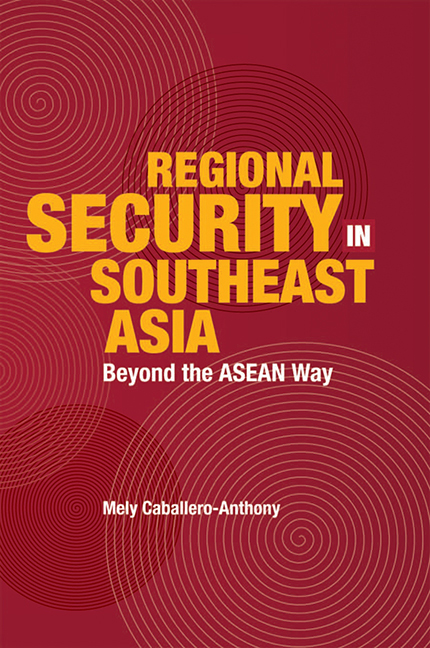Book contents
- Frontmatter
- Contents
- Acknowledgements
- INTRODUCTION: Regional Security in Southeast Asia: Beyond the ASEAN Way
- 1 Regionalism and Regional Security: Locating ASEAN
- 2 ASEAN's Mechanisms of Conflict Management: Revisiting the ASEAN Way
- 3 ASEAN and the Cambodian Conflict: Testing the Limits of the ASEAN Way
- 4 ASEAN Regional Forum: Extending the ASEAN Way in Managing Regional Order
- 5 ASEAN's Track Two Diplomacy: Reconstructing Regional Mechanisms of Conflict Management
- 6 The Asian Economic Crisis and Other Challenges: Turning Points Beyond the Comfort Zone?
- 7 ASEAN and Civil Society: Enhancing Regional Mechanisms for Managing Security
- 8 Conclusion: Beyond the ASEAN Way
- APPENDIX I Declaration of ASEAN Concord II (Bali Concord II)
- APPENDIX II Recommendations of the High-Level Task Force on ASEAN Economic Integration
- APPENDIX III ASEAN Vision 2020
- APPENDIX IV Declaration of ASEAN Concord
- Selected References and Further Readings
- Index
- About the Author
4 - ASEAN Regional Forum: Extending the ASEAN Way in Managing Regional Order
Published online by Cambridge University Press: 21 October 2015
- Frontmatter
- Contents
- Acknowledgements
- INTRODUCTION: Regional Security in Southeast Asia: Beyond the ASEAN Way
- 1 Regionalism and Regional Security: Locating ASEAN
- 2 ASEAN's Mechanisms of Conflict Management: Revisiting the ASEAN Way
- 3 ASEAN and the Cambodian Conflict: Testing the Limits of the ASEAN Way
- 4 ASEAN Regional Forum: Extending the ASEAN Way in Managing Regional Order
- 5 ASEAN's Track Two Diplomacy: Reconstructing Regional Mechanisms of Conflict Management
- 6 The Asian Economic Crisis and Other Challenges: Turning Points Beyond the Comfort Zone?
- 7 ASEAN and Civil Society: Enhancing Regional Mechanisms for Managing Security
- 8 Conclusion: Beyond the ASEAN Way
- APPENDIX I Declaration of ASEAN Concord II (Bali Concord II)
- APPENDIX II Recommendations of the High-Level Task Force on ASEAN Economic Integration
- APPENDIX III ASEAN Vision 2020
- APPENDIX IV Declaration of ASEAN Concord
- Selected References and Further Readings
- Index
- About the Author
Summary
INTRODUCTION
The previous chapter discussed ASEAN's first major attempt at resolving an extramural dispute involving countries, which at that time were not yet members of this association. As discussed, ASEAN's involvement in the conflict was also problematic right from the start. As far as Vietnam was concerned, the Cambodian dispute was an internal dispute that no external party had any locus standi to intervene. But for ASEAN, the Vietnamese occupation posed varying threats to regional security and was a blatant violation of the international, and in particular, ASEAN's norms on non-use of force and non-interference in domestic affairs. ASEAN, therefore, was deeply involved in finding a political settlement for the Cambodian conflict.
Among the many salient points that can be learnt from ASEAN's experience in Cambodia are the kinds of limitations that regional organizations face in managing extra-regional disputes. Firstly, notwithstanding its lack of capacity to intervene in the conflict, ASEAN was severely handicapped by the very nature of the conflict. Not only were there differences in position as to whether the Cambodian conflict was an internal matter, the parties involved in the conflict had not also given their consent to the mediating role that ASEAN took on. This made ASEAN's mandate in the resolution of the conflict controversial. Secondly, the conflict became less manageable and more intractable when major powers were involved and their co-operation was not forthcoming. One notes that ASEAN's efforts in the pushing ahead with the “Cocktail” talks were hampered when the United States refused to recognize the Coalition Government of Democratic Kampuchea (CGDK) forces and when China became less hostile to Vietnam. The conflict, therefore, became much more complex when ASEAN found itself having to accommodate the positions of the major powers vis-à-vis the positions of the warring Cambodian factions.
- Type
- Chapter
- Information
- Regional Security in Southeast AsiaBeyond the ASEAN Way, pp. 113 - 156Publisher: ISEAS–Yusof Ishak InstitutePrint publication year: 2005



